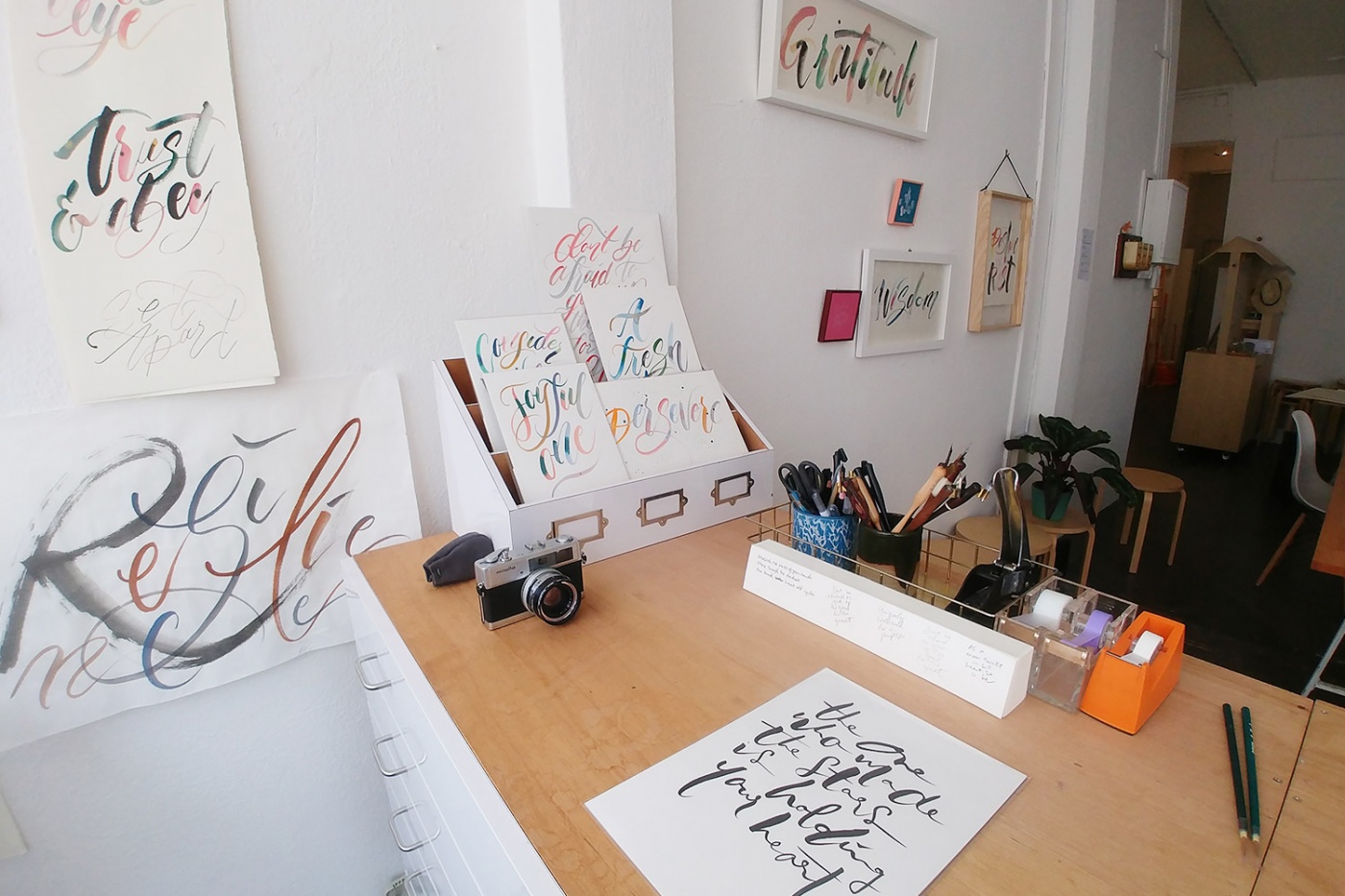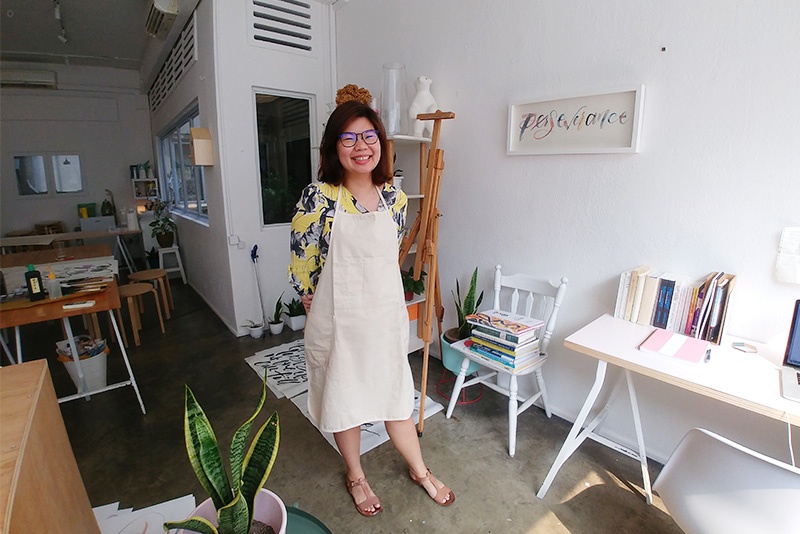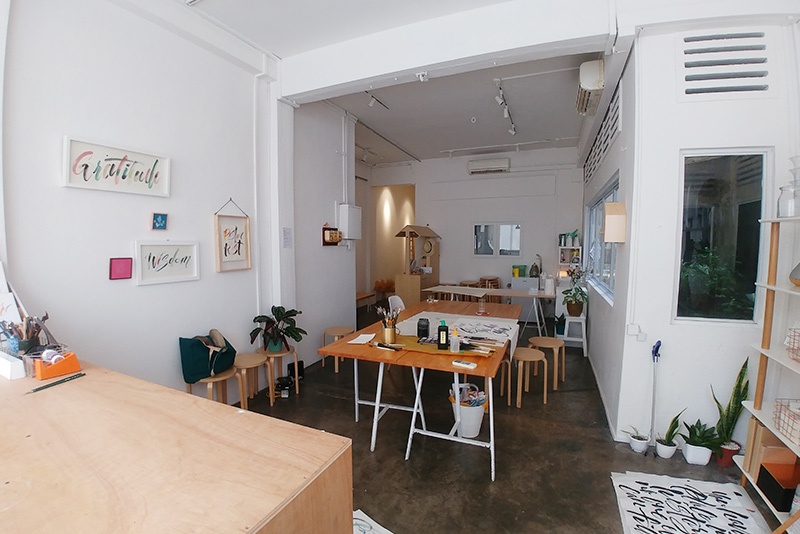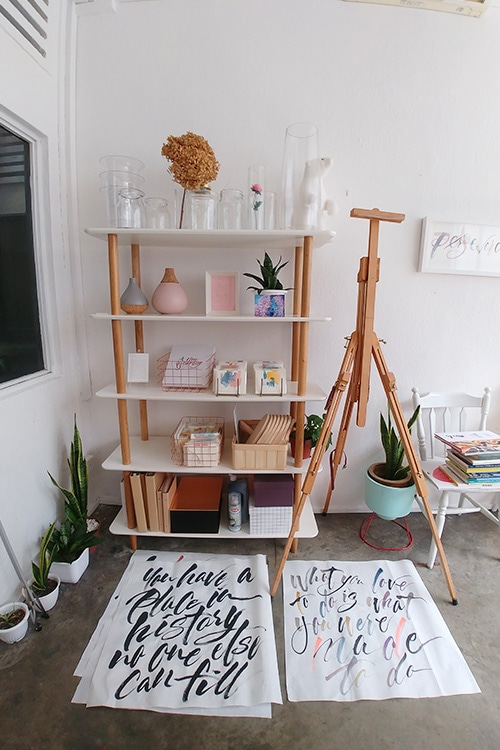Inside The Letter J Supply with Joanne Lim
On the main door hangs an old signboard: “Kheng Zai Cheng Clan Association”, juxtaposed with a modern stencil that reads: “A Different Clan”. But once you push through the door, you’ll find yourself in a Muji-like showroom—clean, yet minimalistic, with simple undertones that are enhanced by soothing pastel artwork created by Joanne Lim, the founder of The Letter J Supply.
Half-length windows allow sunlight to seep in partially, and with the soft Jazz music in the background, time seems to pass languidly. And I soon discover that she is working on a special set of monthly calendar cards, featuring inspirational quotes for Bynd Artisan. As we begin conversing, I notice how her effervescent personality is reflected in her work—from the choice of bright watercolours to the use of thick paint brushes—each stroke injecting new life into the lost art of calligraphy. Creativity runs in Joanne’s blood, having spent the last 10 years in graphic design before deciding to pursue calligraphy full-time.
Looking around her studio, the quotes on the wall resonate with own her beliefs. “Perseverance” serves as a reminder not to give up during a period when she faced multiple rejections by calligraphy experts who refused to teach her the craft. And “Gratitude and Wisdom” remind her of the people who have supported her journey, and the times when their advice has helped her gain a new perspective.
HNW: How did The Letter J Supply start?
Joanne Lim: About 3 and a half years ago, I was working in a church as a graphic designer and I wasn’t sure if that was what I wanted to do—when a good friend of mine gave me a set of tools from Japan. It consisted of a brush pen, a nib and a bottle of ink, which made me intrigued. Not long after, I went to the States for a holiday and while I was in New York, I attended a calligraphy talk. During the talk, I found out that most of the attendees were teachers, so I went up to them asking if they could give me private classes. Unfortunately, most of them rejected me. I was quite persistent until a lady named Eleanor Winters finally agreed and gave me her card. Thereafter, I started taking private lessons at her house for two and a half weeks during my one month holiday. When I came home, I felt that the computer was very cold in comparison to the feeling of writing, so I decided to leave my job and pursue something on my own.
My friend who had a shop space at Shaw Tower asked if we want to share the space together. And the rental was only $1000. We could do whatever we wanted in the space, so that was how it started. The name, “The Letter J Supply” came from a friend who randomly said, “Why don’t you call it the letter J?” I didn’t really think too hard about it, but it made sense because “J” is the initial of my first name and since I’m a Christian, “J” is for Jesus as well.
How was the response from your family and friends?
I was very lucky that a lot of people were supportive of me and gave me good business advice. I don’t recall anyone telling me not to start my own business—even my parents gave me a lot of freedom to try and see if I could make it work. I basically gave myself a year.
Talk to us about your current space.
Before I took over the space, the previous tenant was Supermama, and they kept some of the old fixtures like the ceiling fan switch, which I’ve left untouched. We also retained the minimalistic vibe and look, and added our own character when we came in. We co-share this unit with the Kheng Zai Cheng Clan Association, and I’m happy with this arrangement.
What do you like about it?
I love the big window although the view is now being blocked by renovation work, which overlooks the shops at Raffles Hotel. I want customers to feel at ease because of the natural sunlight that brightens up the entire room, creating an air of spaciousness.
How did calligraphy become a business for you?
It was a slow transition. While I was at Shaw Tower, I was still doing freelance work because it was hard to make ends meet. I had to keep doing events in order to get people to come to our calligraphy workshop. But I feel extremely blessed. My teacher wanted to come to Singapore to teach and asked me to organise a workshop for her. The workshop turned out to be a success, and since then, business has stabilised a lot more. Now, I can stop doing design and concentrate on the business aspect. I usually teach 3 to 4 classes a month. Each class has about 10 to 14 students and it runs for about 3 and a half hours.
Where do you get your inspiration from?
I have a secret hobby; I like to watch documentaries on Netflix, and it can be about anything, from singers to photographers. With each documentary, I learn something new because I see how passionate they are about their craft and how much adversity that they had to overcome just to live out their dream.
My work varies depending on the different tools that I use. I really enjoy getting new tools, because each of them has a different characteristic and what comes out can be something spontaneous. I don’t really have a template that I follow.
Favourite paper and ink combination? And a quote that best fits you?
Currently, I quite like watercolour paper that I got from Bynd Artisan. It has a cottony material, and I don’t think it is available in Singapore. The people from Bynd Artisan have been very kind to give me a whole stack of them. In addition, I am experimenting with Chinese ink and Japanese pigment. When I first started, I used a lot of watercolours and dyes, but I realised that under the light, it fades quite fast. So I am trying to move away from that.
“What you love to do, is what you were made to be.”—I came up with that because it encompasses what I’m trying to do.
What does the future hold for you and The Letter J Supply?
Personally, I am trying to do bigger artwork, away from the usual A4 or A3 sizes, as well as explore Eastern influences like the use of Chinese brushes. I took a class in Chinese calligraphy and felt very inspired by their philosophy. Asian artwork is more sophisticated and in terms of calligraphy, Western calligraphy focuses more on precision whereas Chinese calligraphy is more about the “feeling” and spontaneity with each stroke.
I hope that next year, I can conduct workshops on penmanship. I realise that our education system has an impact on our handwriting—based on my observations, a lot of Singaporeans who are under 30, have handwriting that is a little robotic. It does not flow as well as people who are in their 40s to 60s. I think that has to do with our education system and that it can be taught. Kids should have extra classes to learn penmanship. The friend that gave me the set of tools, knew about penmanship, because when she was studying, the nun in her school was shocked by their handwriting and forced them to stay back to learn calligraphy. How you write shows what kind of character you have.





